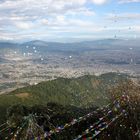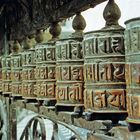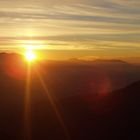Days: 1 / Difficulty: 1 of 5 (Easy)
Min Group Size: 1 /
Max Group Size: 12
Some important monuments seen in this area are:
- The Taleju temple, it is the tallest of all structures built by King Mahendra Malla in 1549 A.D.
- The Jagannath temple, built in the 16th century, is known for the fascinating erotic figures carved in the wooden struts.
- The Kala Bhairav, one of the largest 17th century stone statue in Kathmandu, represents the terrifying aspect of Shiva.
- The statue of King Pratap Malla is placed on top of a stone pillar right across the temple of Digu Taleju, the royal family deity.
- The 17th century Kumari temple (the temple of the living goddess is an example of the highly developed Nepali craftsmanship).
- Kastamandap, from which Kathmandu derives its name, is said to have been built from the timber of a single tree.
So, what to choose....you can choose 3 places for Kathmandu Valley Sightseeing.
The best options are as follows for full day sightseeing:
# Option 1:- Boudhanath Stupa, Swoyambhunath Stupa and Pashupatinath Temple
Tour Price for 1 person: USD 125
Tour Price for 2 persons: USD 185
# Option 2:- Bhaktapur Durbar Square and Patan Durbar Square
Tour Price for 1 person: USD 140
Tour Price for 2 persons: USD 210
# Option 3:- Kathmandu Durbar Square, Swoyambhunath Stupa, Boudhanath Stupa and Pashupatinath Stupa
Tour Price for 1 person: USD 160
Tour Price for 2 persons: USD 230
Note: Choosing your own tour places may change in the price due to entrance fees difference.
1. Kathmandu Durbar Square:
Kathmandus Durbar Square is one of three durbar (royal palace) squares in the Valley. It is the site of the Hanuman Dhoka Palace Complex, which was the royal nepalese residence until the 19th century and where important ceremonies, such as the coronation of the nepalese monarch, took place. The palace is decorated with elaborately-carved wooden window and panels. The same palace holds the King Tribhuwan Memorial and the Mahendra Museum. It is also possible to visit the State Rooms inside the palace. At the southern end of Durbar Square is one of the most curious attractions in Nepal, the Kumari Chowk. This gilded cage contains the Raj Kumari, a young girl, chosen through an ancient and mystical selection process, to become the human incarnation of the Hindu mother goddess, Durba. She is worshipped during religious festivals and makes public appearances at other times for a fee paid to her guards.
2. Bouddhanath Stupa:
The largest stupa in Nepal and revered by both Tibetan and Newar Buddhist. The Tibetans believe, that the stupa contains the bone relics of the past Buddha Kashyapa. The colossal and ancient stupa of Bouddhanath is 36 meter high. At the ground level there is a brick wall with 147 niches and 108 images of the meditational Buddha inset behind copper prayer wheels. Early morning and evening are the times to visit Bouddha to join the local residents in Khora (walking the pilgrim’s circuit, sometimes with Tibetan pilgrims on their hands and knees).
3. Swayambhunath (Monkey Temple):
Swayambhunath is one of the most glorious Buddhist stupa. It is said to be 2000 years old. Painted on the four sides of the spire’s base, are the ‘all seeing eyes’ of Lord Buddha, keeping an eternal watch on the valley distinguishing between vice and virtue. Swayambhunath is, perhaps, the best place to observe the religious harmony in Nepal. The stupa is among the most ancient in this part of the world and its worshippers are many diverse people like Newar nuns, Tibetan monks, Brahaman Priests and lay Buddhist and Hindus. Swayambhu is a major landmark of the valley and looks like a beacon below the Nagarjun hill. It provides an excellent view of the Kathmandu valley.
4. Pashupatinath:
Pashupatinath is one of the most sacred temples in the entire Hindu world. It is a sacred place where Hindus come(to die and) to be cremated. The temple of Pashupatinath is a large double roofed, gilt pagoda, decorated with brass, the gateway is plated with silver. There are images of Shiva along with other statues, shrines and temples dedicated to other deities in the complex. A circuit of the Pashupati area takes visitors past a sixth-century statue of the Buddha, an eight-century statue of Brahma the creator and numerous other temples. There are rows of Shiva shrines and Hindu pilgrims from all over south Asia offering ceremonies to worship Shiva, the Lord of Destruction. Entrance to the temple precinct is permitted to the Hindus only. However visitors can clearly see the temple and the activities performed in the temple premises from the eastern bank of the Bagmati River.
5. Patan Durbar Square:
Patan Durbar Square boasts of many famous sites and unique architectures. The ancient palaces, temples and shrines with exquisite carving are scattered around Patan Durbar Square. The major attractions of Patan Durbar Square are the stone temple of Lord Krishna, the Royal Bath with many carvings on stone, Viswanath temple and the temple of Bhimsen with a magnificent golden balcony overlooking the square. Many more temples are dedicated to Ganesh, the elephant-headed god, Shiva, Narsingh, Taleju and others, situated in the Patan Durbar Square.
6. Bhaktapur Durbar Square:
Bhaktapur Durbar Square is a conglomeration of pagoda- and shikharastyle temples, grouped around a fiftyfive-window palace of bricks and wood. The square is one of the most charming places, as it highlights the ancient history of the kings, perched on top of stone monoliths. The guardian deities looking out from their sanctuaries, the wood carvings in every place; in struts, lintels, tympanums, gateways and windows, all seem to form a well orchestrated symphony.
The main items of interest in the Durbar Square are: Lion Gate, the statue of King Bhupatindra Malla, the Picture Gallery, the Golden Gate, the palaces of 55 windows, the Batsala temple and the bell of barking dog etc.
7. Kirtipur:
The small town of Kirtipur is 5km southwest of Kathmandu. In the past there were 12 gates of the town. Parts of the old city wall still preserved. There are some great views of Kathmandu and the mountains behind it. Kirtipur is on two hills. On the saddle between those hills is the holy Bagh Bhairab temple, where Hindus and Buddhists meet.
8. Buddhanilkantha:
About eight kilometers north of Kathmandu, at the base of Shivapuri hill, is a remarkable colossal statue of Lord Vishnu, reclining on a bed of snakes. This stone sculpture is from the Lichchhavi period, it’s a fifth-century statue. It is placed in the middle of a small pond and seems to float on the surface of the water. It is popular pilgrimage site for Hindus.
Join with us on Day Tours in Kathmandu in 2025/2026.
Customize Your Tour: This is a general itinerary, which can always individually be “tailormade”. The trek package can be redesigned or redeveloped as per your taste, For more information please e-mail us at snftnepal@yahoo.de
Important: In case of emergency during the trip, Helicopter will be arranged by Swiss Himalayan Family Treks and Expedition Pvt. Ltd. The charges must be paid by the clients themselves.



























